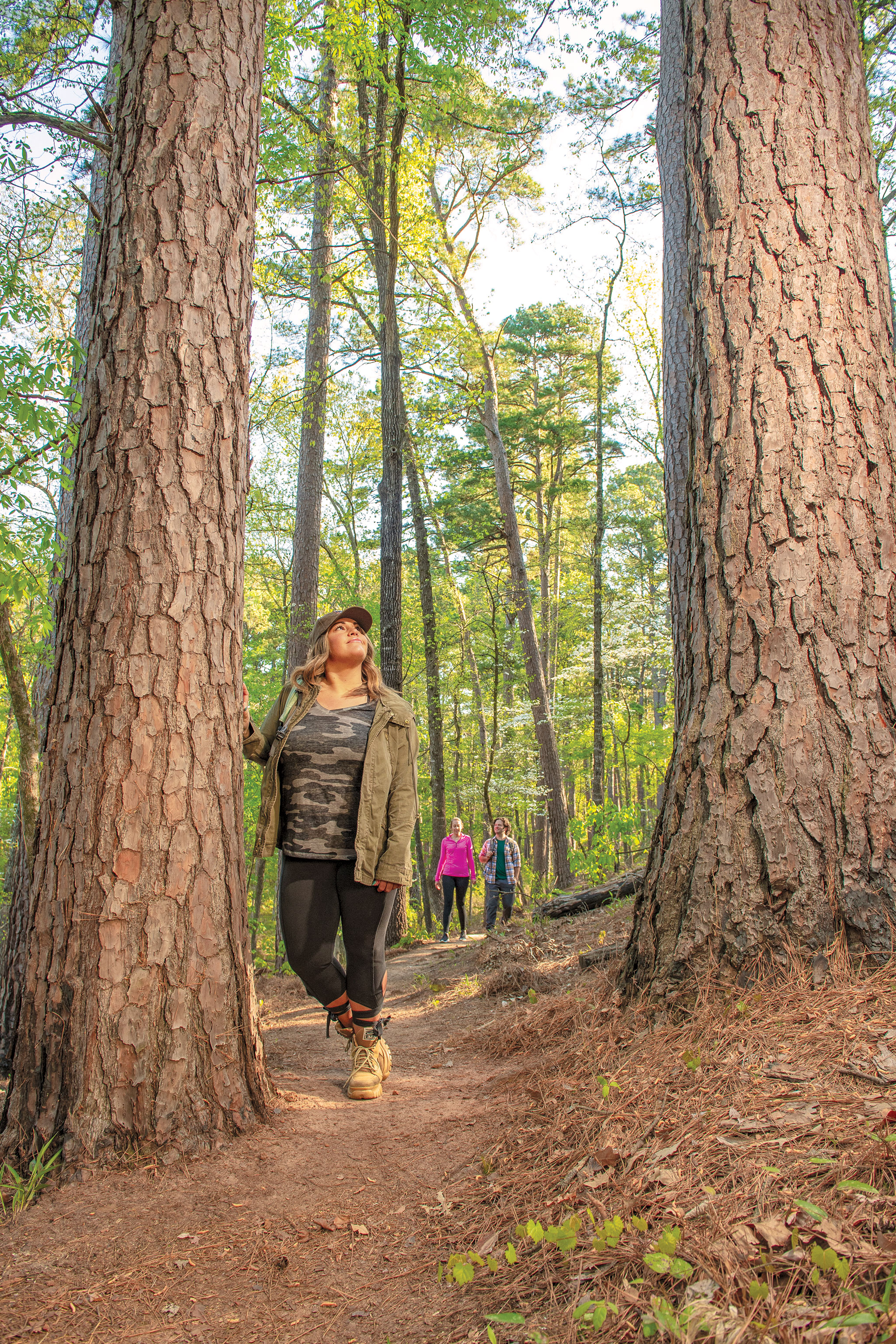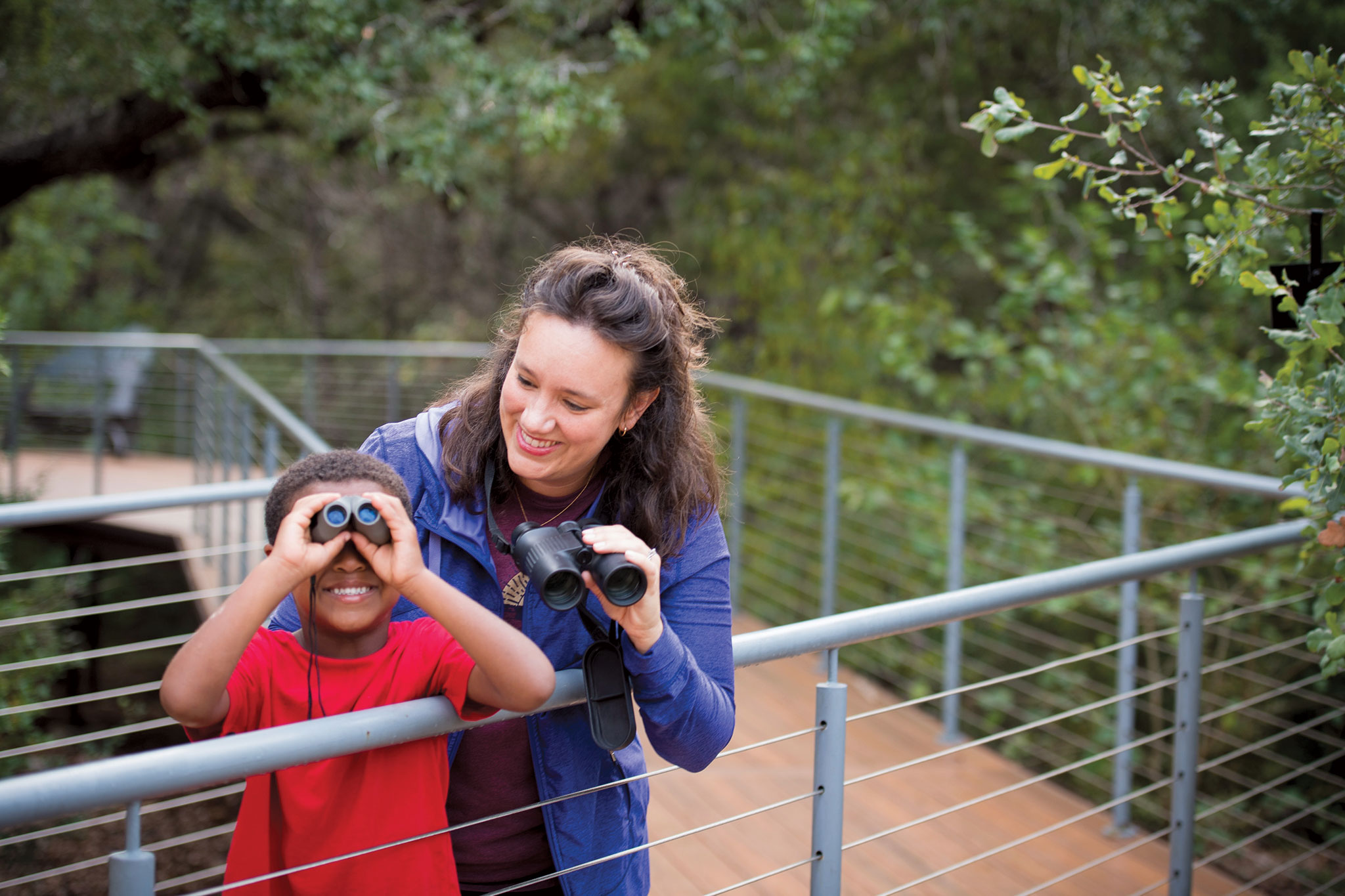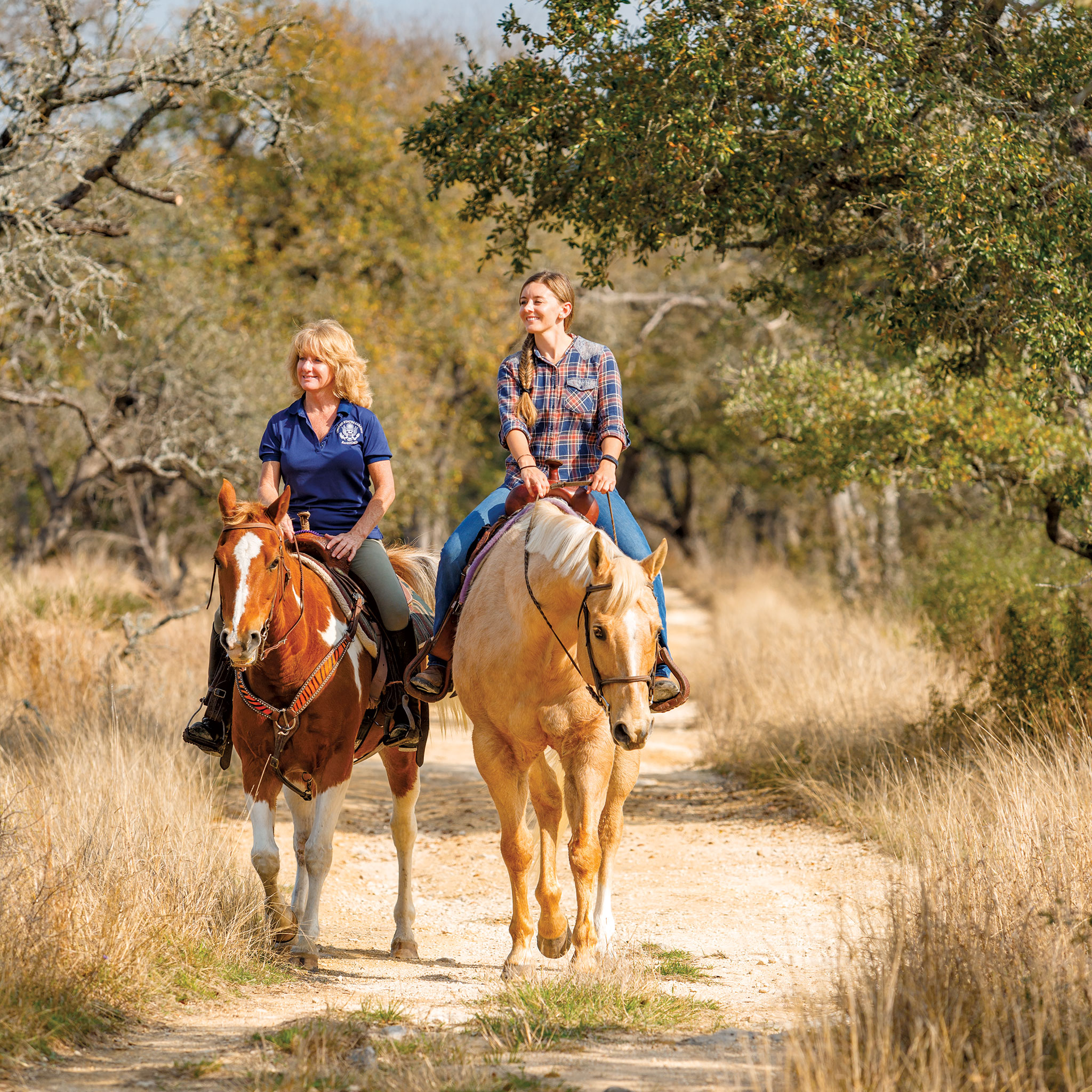
Photo by Sonja Sommerfeld / TPWD
Caddy Trail at Lockhart State Park
Blaze a Trail
TPWD offers land and water routes for every interest and skill level.
By Russell Roe
When Brownsville city leaders went looking for something that would increase the health of the city’s residents, provide overall community benefits and boost economic opportunities, they found their solution in an unexpected place: trails. The resulting Active Plan envisions a 428-mile network of cycling, walking and paddling trails in the Rio Grande Valley.
When Colleen Simpson took over as parks director in Port Aransas, one of her top priorities was trails. The city’s birding and nature sites existed independently of each other, and Simpson wanted to connect them. Her new parks master plan, approved last spring, calls for an interconnected system of hike-and-bike trails to link the parks.
Trails take us places. They connect us. They let us experience nature. They put sweat on our brow and a smile on our face.
Trails contain the wisdom of those who walked before us.

“Trails have shaped our bodies, sculpted our landscapes and transformed our cultures,” Robert Moor writes in the book On Trails. “In the maze of the modern world, the wisdom of trails is as essential as ever.”
Like ants and elephants, we create trails to guide our journeys, transmit messages and make sense of the world — reducing our infinite choices to a single path, carved out of the dirt.
The Texas Parks and Wildlife Department operates the most extensive and diverse system of trails in the state, with a variety of trails catering not only to hikers, but also paddlers, cyclists, horseback riders, wildlife watchers and history buffs.
TPWD trails take us by foot through pine forests, by bike down Hill Country canyons, by horse through rugged West Texas mountains, by car down the coast to chase migrating songbirds and by kayak through mangrove-filled estuaries.
“Trails are all about connecting people with nature, and Texas is lucky to have so many different kinds to choose from,” says Shelly Plante, nature tourism director for TPWD. “From wildlife viewing and paddling trails to mountain biking and equestrian trails, there are countless options to explore in our state. To make it easy for folks to discover their next trail, we’ve put together programs and resources for all interests and abilities.”
Rangers lead hikes on Texas state park trails every weekend, including January’s kickoff First Day Hikes. TPWD’s paddling trail program has expanded access to water recreation across the state. Its Great Texas Wildlife Trails have become a model for driving tours in other states.
“By creating trail networks and sharing that information through maps and programs, we hope to make it easier to find the best places to visit in Texas,” Plante says.
“Trails are all about connecting people with nature, and Texas is lucky to have so many different kinds to choose from.”

Photo by Chase Fountain / TPWD
Let's Hike
Every year my family camps with a group of other families at Colorado Bend State Park. And every year we hike the Spicewood Springs trail, a path that follows the enchanting Spicewood Springs Creek up a canyon. Crystal-clear pools and cascading waterfalls mark the way up the rocky path. We always get our feet a little wet as we hop from rock to rock on the multiple creek crossings. We can’t get enough of the spring-fed creek as it tumbles down the travertine limestone formations on its way to the Colorado River. There’s a nice swimming hole at the mouth of the canyon, and a certain teenage member of our group always insists on jumping in, no matter the weather.
We’ve done the Gorman Falls trail (the park’s most popular) and others in the park, but this is the one we keep coming back to. I think it’s one of the best little hikes in Central Texas.
If I were to list my family’s favorite state park trails, they’d probably be Colorado Bend’s Spicewood Springs Trail, Enchanted Rock’s Summit trail and Big Bend Ranch’s Closed Canyon trail.
The spring-fed waterfalls, big granite dome and narrow slot canyon on those trails are just a few of the scenic attractions that can be found on state park trails. Park trails range from short nature hikes to full-day treks through a park’s most remote stretches.
For a hike through East Texas pines, try Tyler State Park’s 1-mile Whispering Pines trail, built by the Civilian Conservation Corps in the 1930s, or the more ambitious 6.8-mile Chinquapin trail around Huntsville State Park’s Lake Raven.
For Hill Country beauty, the east trail at Lost Maples State Natural Area follows the Sabinal River with its bigtooth maple and bald cypress trees before heading uphill with spectacular views into the valleys below. Garner’s Old Baldy trail is a longtime favorite that rewards hikers with a bird’s-eye view of the Frio River canyon.
For West Texas grandeur, Franklin Mountains offers treks to Aztec caves or to the summits of El Paso’s highest mountains. At Seminole Canyon, hikes take visitors to ancient pictographs and historic railroad artifacts.
Go to texasstateparks.org/hiking for information.

Photo by Earl Nottingham / TPWD
Let's Paddle
TPWD started its paddling trails program after coastal conservation scientist Bill Harvey got lost in the Lighthouse Lakes section of Redfish Bay near Port Aransas in the late 1990s. He had been kayaking by himself, and when the sun went down, he couldn’t find his way out of the maze-like, mangrove-filled estuary.
“It’s got great fishing, and it’s really beautiful,” Harvey says. “I figured if we could map it, it would get a lot of use.”
He was right.
The development of the early coastal paddling trails coincided with the boom in kayak fishing, and coastal paddling hasn’t been the same since.
Paddling trails are designated sections of waterways with a start point and an end point. Signs and maps provide information about length, trip highlights and paddler experience needed. After the Lighthouse Lakes Paddling Trail launched in 1999, the paddling trail program moved inland in 2006 with the opening of the Luling–Zedler Mill Paddling Trail in Luling. Paddling trails can now be found on dozens of Texas rivers, lakes and bays. The Sabine Sandbar Paddling Trail opened in fall 2019 to become the 78th Texas paddling trail.
“We’re trying to increase public access to waterways in Texas while also making it very easy for a new paddler or a family,” Plante says. “By designating these manageable stretches of river, lake and bay as paddling trails, we’ve made these more accessible trips for people who maybe aren’t as comfortable on the water yet. We want to take some of the mystery out of being on the water.”
Texas isn’t exactly known for its whitewater, but the Upper Guadalupe–Nichol’s Landing Paddling Trail contains several rapids for a rollicking ride down the Guadalupe River. The Goliad Paddling Trail, the first paddling trail to include a state park, takes kayakers and canoeists down the San Antonio River to one of Texas’ most historic sites. In Houston, the Buffalo Bayou Paddling Trail juxtaposes views of wildlife and downtown. And the Walnut Slough Paddling Trail at Martin Dies Jr. State Park encircles an island in the Big Thicket.
Go to tpwd.texas.gov/paddlingtrails for more information.

Photo by Chase Fountain / TPWD
Let's Drive
If you’re a big birder, a dragonfly devotee, a bat booster or any kind of wildlife watcher, the Great Texas Wildlife Trails will help you see the wild side of Texas. The program’s nine driving trails contain wildlife hot spots across the entire state.
The wildlife trail maps include publicly accessible sites such as state parks and city preserves, with descriptions of what can be seen at each place. In the Rio Grande Valley, the Santa Ana Loop of the Great Texas Coastal Birding Trail includes Quinta Mazatlan, which promises chachalacas, great kiskadees and green jays. (Other stops on the loop include the Santa Ana National Wildlife Refuge, the Edinburg Scenic Wetlands and the McAllen Botanical Garden.)
At the Gene Howe Wildlife Management Area, which is a stop on the Canadian Breaks Loop of the Panhandle Plains Wildlife Trail, prairie dogs are a top attraction along with wild turkeys, Mississippi kites and grassland birds. On the Texas coast this time of year, boat tours to Aransas National Wildlife Refuge — listed as a stop on the Aransas Loop of the Great Texas Coastal Birding Trail — offer a chance to see endangered whooping cranes, North America’s largest bird.
“The beauty of a Great Texas Wildlife Trail is that it packages all the wildlife viewing sites in an area to make them easier to find,” Plante says. “You might go to visit a state park but then stay to visit the other stops on the trail.”
The idea to group wildlife sites into a wildlife driving trail was hatched at TPWD in 1996 with three birding trails along the coast. Texas now has wildlife driving trails across the state. Other states have embraced the idea as well.
“We were the first ones to have wildlife trails,” Plante says. “At that time, no other state had one. Now, over 40 states have birding or wildlife trails based on the Texas model.”
Go to tpwd.texas.gov/wildlifetrails for more information and to order maps.

Photo by Earl Nottingham / TPWD
Let's Bike
Mountain biker Chris Podzemny loves the feeling of zipping around corners, down straightaways and over rocks in the canyon country of Palo Duro Canyon State Park.
“I love cycling, and I love being in nature,” he says. And at Palo Duro, he appreciates “the wildlife, geology and history of the canyon.”
His passion for riding led him to give back to the park by building trails.
“We have some of the best trails in the state of Texas in Palo Duro Canyon,” he says. “The red clay soil makes for incredibly fast, smooth, flowy trails. Then as you climb the canyon walls on our trails, there’s plenty of challenge, too.”
State parks give mountain bikers some of the best places to ride trails in Texas.
Big Bend Ranch State Park offers 200-plus miles of remote desert trails, including a route deemed an “Epic” ride by the International Mountain Biking Association.
In North Texas, Cedar Hill State Park and Ray Roberts Lake State Park provide adventure for mountain bikers of varying skill levels. Tyler State Park’s trails include hills and loops through Pineywoods terrain. The rails-to-trails pathways at Lake Mineral Wells and Caprock Canyons are options for longer, smoother rides.
Go to texasstateparks.org/biking to learn more.

Photo by Earl Nottingham / TPWD
Let's Ride
If you long for the cowboy days of yore, you can live out your dream on a state park equestrian trail. Some parks feature equestrian-only trails; at others, horseback riders share the trails with hikers and mountain bikers. In addition, several parks offer equestrian campsites.
You can ride through rugged terrain at Davis Mountains State Park with scenic views of mountains and valleys. On the other side of the state, Sea Rim State Park offers miles of shoreline where horses can gallop on the beach.
Hill Country State Natural Area is one of the most popular state parks for equestrians, with its canyons, scenic plateaus and tranquil creek bottoms near Bandera, the “Cowboy Capital of the World.” For a real taste of old Texas, take a ride at Fort Richardson, with its fort structures and 9-mile Lost Creek Reservoir State Trailway, or San Angelo State Park, with its 50 miles of multiuse trails and longhorns from the official state herd.
Cooper Lake State Park offers equestrian riding and camping in North Texas.
“We have over 10 miles of equestrian trails,” says Steve Killian, Cooper Lake complex superintendent. “They wind through the post oak forest, and there’s a good bit of up and down with occasional glimpses of Cooper Lake. Plus, the equestrian campground is located right at the trailhead.”
Russell Roe serves as managing editor and resident trails guru at Texas Parks & Wildlife magazine.
Related stories
» Like this story? If you enjoy reading articles like this, subscribe to Texas Parks & Wildlife magazine.

